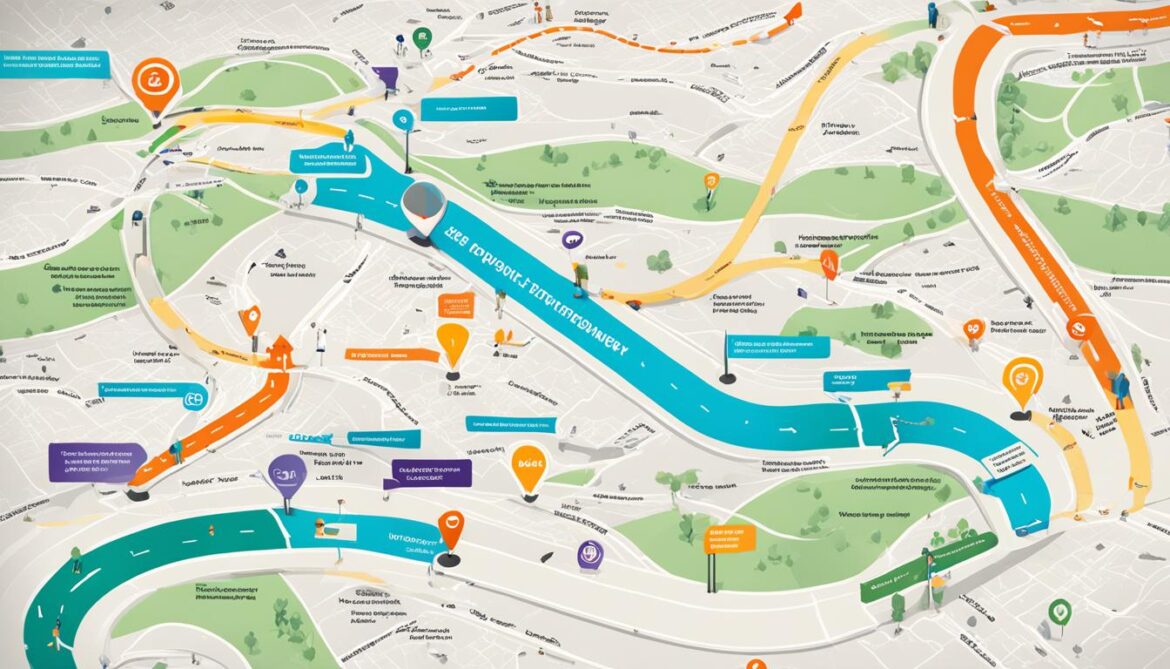A customer timeline journey is a crucial aspect of understanding your customers and the experiences they have with your brand. It involves mapping out the various touchpoints and interactions that occur throughout a customer’s relationship with your business. By creating a customer experience map, you can gain valuable insights into the customer journey, identify pain points, and make informed decisions to improve your business.
A customer journey map provides a visual representation of the entire customer journey, allowing you to see how customers engage with your brand at different stages. This map helps businesses understand the customer’s processes, needs, and perceptions, enabling them to prioritize the customer experience and align their objectives accordingly.
Key Takeaways:
- Mapping the customer timeline journey helps businesses identify potential issues and improve customer retention.
- Customer journey maps provide insights into customer thoughts and emotions, allowing for necessary improvements to products, services, and overall customer experience.
- Understanding the customer journey enables data-driven decision-making and helps align business strategies with customer needs.
- When creating a customer journey map, start by aligning it with a chosen customer persona and consider all customer touchpoints.
- Surveys play a crucial role in developing a customer journey map by providing first-hand customer feedback and measuring satisfaction and loyalty.
What is a Customer Journey Map?
A customer journey map is a powerful tool that visually represents every interaction a customer has with a brand over a specific period of time. It outlines the various touchpoints between the customer and the brand, starting from brand advertising and leading to direct interactions with products, websites, or support teams. This map provides valuable insights into customer thoughts, emotions, and behaviors throughout their journey.
By creating a customer journey map, businesses can gain a deeper understanding of their customers’ experiences and identify pain points or areas for improvement. It allows companies to step into the customer’s shoes and view their journey from their perspective. This understanding enables businesses to make necessary adjustments to their products, services, and overall customer experience, leading to improved customer satisfaction and loyalty.
Customer journey maps are essential for developing a comprehensive marketing strategy. They help companies align their business objectives with the customer experience, ensuring that every touchpoint reflects the brand’s values and meets customer expectations. By prioritizing the customer journey, businesses can create a seamless and cohesive experience across all brand touchpoints, from initial awareness to post-purchase support.
A customer journey map not only benefits the marketing department but also provides valuable insights for other areas of the business. It helps product development teams understand customer needs and pain points, guides customer service representatives in delivering personalized support, and assists sales teams in identifying opportunities for upselling or cross-selling. Ultimately, a well-developed customer journey map forms the foundation for a customer-centric approach that drives business growth and success.
How Can Customer Journey Maps Improve Customer Experiences?
Customer journey maps offer numerous benefits in enhancing customer experiences. By gaining an understanding of the customer’s journey, businesses can identify pain points and proactively address them. This proactive approach leads to increased customer retention as customers feel understood and valued throughout their interactions with the brand.
Moreover, customer journey maps serve as valuable tools for making data-driven decisions. They provide insights into customer needs and expectations, allowing businesses to align their strategies accordingly. By prioritizing the customer experience throughout the organization, companies can enhance their decision-making processes and ensure that every aspect of their business strategy aligns with the customers’ journey.
Utilizing customer journey maps ensures that businesses focus on creating a seamless and personalized experience for their customers at every touchpoint. By identifying key moments in the journey where customers may encounter difficulties or friction, companies can implement targeted improvements that address these pain points. This, in turn, leads to improved customer satisfaction, increased loyalty, and a stronger competitive edge in the market.
Where Do I Start with My Customer Journey Map?
When creating a customer journey map, it is important to align it with a chosen customer persona. A customer persona represents the average customer based on research and helps businesses understand their needs and preferences.
Start by identifying your target audience and gather relevant data to create a comprehensive customer persona. This includes demographics, psychographics, and behavioral information. Understanding your customers’ motivations, pain points, and aspirations will enable you to craft a more accurate and impactful journey map.
Once you have a clear understanding of your customer persona, the next step is to define your business goals. Determine what you want to achieve with your customer journey map. Are you looking to increase conversion rates, improve customer retention, or enhance customer satisfaction? Define specific and measurable goals that align with your overall business objectives.
As you begin mapping the customer journey, consider the touchpoints where your customers interact with your brand. These touchpoints include website visits, social media engagement, customer support interactions, and more. Ensure that you include all relevant touchpoints to capture the complete picture of your customers’ experiences.
Remember that a customer journey map is a dynamic tool that can evolve over time. As your business grows, new touchpoints may emerge, and customer preferences may change. Regularly update and refine your customer journey map to keep it up to date and aligned with your evolving customer needs and business goals.

By starting with a well-defined customer persona, setting clear business goals, and considering all relevant customer touchpoints, you can create a robust and actionable customer journey map. This map will provide valuable insights into the customer experience, enabling you to optimize processes, address pain points, and deliver a seamless and delightful customer journey.
Why Are Surveys Crucial for Developing My Customer Journey Map?
Surveys are an essential tool for developing a comprehensive customer journey map. By collecting survey data, businesses can gather valuable insights and feedback directly from their customers. This information is crucial for understanding the customer experience, identifying pain points, and making informed decisions to enhance the overall customer journey.
Through surveys, businesses can capture customer feedback on various aspects of their interactions, such as their satisfaction levels, loyalty, and overall experience. Surveys like the Net Promoter Score (NPS), Customer Satisfaction Score (CSAT), and Customer Effort Score (CES) offer valuable metrics to measure customer perceptions and sentiments.
Integrating survey data into the customer journey map enables businesses to analyze and interpret the feedback received, identifying trends, patterns, and areas for improvement. By consistently monitoring and acting upon customer feedback, businesses can proactively address issues, enhance the customer experience, and cultivate long-term customer relationships.
The Benefits of Using Surveys in Customer Journey Mapping:
- Gather first-hand customer feedback and insights
- Measure customer satisfaction, loyalty, and overall experience
- Identify pain points and areas for improvement
- Analyze survey data to make informed decisions
- Proactively address customer needs and expectations
Sample Table: Analysis of Survey Data
| Survey Metric | Score Range | Interpretation |
|---|---|---|
| Net Promoter Score (NPS) | 0-6: Detractors 7-8: Passives 9-10: Promoters |
Identify the percentage of promoters and detractors to gauge customer loyalty and advocacy |
| Customer Satisfaction Score (CSAT) | 1-3: Dissatisfied 4-6: Neutral 7-10: Satisfied |
Evaluate overall customer satisfaction and measure the effectiveness of products, services, or interactions |
| Customer Effort Score (CES) | 1-3: High effort 4-6: Moderate effort 7-10: Low effort |
Determine the level of effort customers need to invest in their interactions and identify opportunities for improvement |
Utilizing the Customer Journey to Enhance Your Business
The customer journey map is a powerful customer-centered tool that businesses can leverage to enhance various aspects of their operations. By visualizing the entire customer journey, organizations can train their team members on customer experience standards, set customer-focused goals, improve onboarding flows, and reduce obstacles throughout the customer lifecycle.
Creating a visual representation of the customer journey enables businesses to establish a united standard for exceptional customer care. It allows companies to gain valuable insights into their customers’ needs, pain points, and expectations, enabling them to make informed decisions and prioritize the customer experience.
Furthermore, a customer journey-focused approach can significantly contribute to increasing customer retention. By identifying pain points and addressing them proactively, businesses can demonstrate their commitment to providing a seamless and personalized customer experience. This, in turn, fosters trust, loyalty, and repeat business.
In summary, utilizing the customer journey as a guiding framework can bring significant benefits to businesses. By using the customer journey map as a customer-centered tool, organizations can enhance their customer service, improve the overall customer experience, and increase customer retention, ultimately leading to long-term business success.
FAQ
What is a customer journey map?
A customer journey map is a visual representation of the entire customer journey, including all touchpoints and interactions a customer has with a brand. It helps businesses understand the customer’s processes, needs, and perceptions.
How can customer journey maps improve customer experiences?
Customer journey maps have several benefits in improving customer experiences. By understanding the customer’s journey, businesses can identify pain points and address them proactively. This can lead to increased customer retention as customers feel understood and valued.
Where do I start with my customer journey map?
When creating a customer journey map, it is important to start by aligning it with a chosen customer persona. A customer persona represents the average customer based on research and helps businesses understand their needs and preferences.
Why are surveys crucial for developing my customer journey map?
Surveys play a crucial role in developing a customer journey map. They provide first-hand customer feedback, allowing businesses to gather data and insights. By including survey data in the customer journey map, businesses can analyze and act on customer feedback regularly, improving the overall customer experience and making informed decisions.
How can I utilize the customer journey to enhance my business?
The customer journey map serves as a customer-centered tool that can be used to enhance various aspects of a business. It can be used to train team members on customer experience standards, set customer-focused goals, improve onboarding flows, and reduce obstacles throughout the customer lifecycle. By creating a visual representation of the customer journey, businesses can set a united standard for exceptional customer care, improve customer experience, and increase customer retention in the long run.







